Buddha nature is continuously present in ourselves as well as in everyone else, without any exception whatsoever. It is in essence forever unobscured. It doesn’t increase or decrease. It is not sometimes covered or uncovered. It is totally beyond mental constructs. It does not change in size. It is not that someone has a big buddha nature and somebody else a small one. There is no difference in quality either. It is continuously present to the same extent in everyone.
To recognize the buddha nature present in oneself is called the view. To sustain the continuity of that correctly is called meditation or training. To mingle that with daily activities and act in accordance with the Dharma is called action or conduct. And to realize it as totally unobscured, like the sun shining with unchanging brilliance in the sky, is called fruition. We need to recognize the view; we need to recognize our buddha nature. Although it is something we already have, we need to acknowledge what we possess. The preliminary practices, the development stage, and so forth are all meant to enable us to recognize the buddha nature. They are like helpers, assistants.
To say “recognize your own nature, the buddha nature!” does not mean that we have to produce something which does not exist, like trying to squeeze gold out of a piece of wood, which is impossible. We must simply recognize what we already possess. But humans, who are the most clever and capable of all the different types of sentient beings, seem to be bent on totally throwing away this most precious wish-fulfilling jewel. The normal state of a human being is like someone who has found a precious wish-fulfilling jewel but ignores it, thinking that a fake piece of jewelry is more valuable. There is nothing sadder or of greater waste than this.
--Tulku Urgyen Rinpoche, in Repeating the Words of the Buddha
Wednesday, December 21, 2005
Wednesday, December 14, 2005
A rare photo
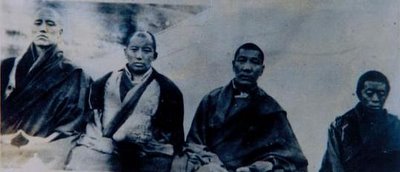 The caption on this rare picture reads "jkclsitushengajamgyal" which supposedly means: Jamyang Khyentse Chokyi Lodro, Katok Situ, Khenpo Shenga, and Jamgyal. It was photographed from a wall in Kham by my friend Mateo, the mad traveler. The first two masters are mentioned throughout Blazing Splendor.
The caption on this rare picture reads "jkclsitushengajamgyal" which supposedly means: Jamyang Khyentse Chokyi Lodro, Katok Situ, Khenpo Shenga, and Jamgyal. It was photographed from a wall in Kham by my friend Mateo, the mad traveler. The first two masters are mentioned throughout Blazing Splendor.
Wednesday, December 07, 2005
Three-Year Retreat Begins at Asura Cave

This year, nearly 200 people participated in our traditional fall seminar at Ka-Nying Shedrub Ling monastery in Boudha. Rinpoche taught an amazing text, “Naturally Liberating Whatever You Meet,” by Khenpo Gangshar, a teacher of Trungpa Rinpoche as well as Trangu Rinpoche. We all felt extremely blessed by Rinpoche’s lucid commentary. The participants all seemed very serious about practice and a wonderful feeling of support and harmony prevailed among the sangha. On the seminar’s break day, everyone was invited to join the celebrations for the beginning of a new three-year retreat in our monastery in Parphing. Eight monks started this retreat, most of them quite young. Rinpoche mentioned during the seminar that he was very touched that even young monks asked for permission to do a three-year retreat. When Rinpoche inquired if they were sure about this, since it would be three years and not just three weeks or three months, some of the monks started to get tears in their eyes, saying that they would like to do at least one valuable beneficial thing in their life, a three-years retreat! Rinpoche asked us to make aspiration prayers so that their retreat will be successful.
On the day of the celebration in Parphing, the athmosphere in the main temple was amazing and very touching. Chökyi Nyima Rinpoche as well as Chokling Rinpoche addressed the retreatants as well as their relatives and friends. Also, Chokling Rinpoche’s wife, Dechen-la, was present and blessed them. Rinpoche often said that Parphing is an especially blessed place, since it was at Asura cave where Guru Rinpoche gained realization through the practice of Vajrakilaya. We are happy to announce that new floors were added to the buildings closest to the hill. Soon there will be more retreat rooms available, built to western standards, including an attached bathroom. Everyone is welcome to use those rooms as soon as they are completed.
--written by Tina Lang
Wednesday, November 30, 2005
From a collection of Tulku Urgyen Rinpoche's favorite songs

From The Hundred Thousand Songs of Milarepa, p. 131-135-folio 56-58
Namo Guru.
Jetsün Milarepa then went from Kyirong in Mang-Yül to Nyanang and his former benefactors we overjoyed. “Please stay always here in Nyanang,” they begged. There was a cave below a belly-shaped boulder between some old trees, and while he resided there, the monk-teacher Shakya Guna and some laypeople of Nyanang came before him.
“While elsewhere in meditation in mountain retreats, please tell us about the progress you reached and the confidence that you attained,” they asked. In reply, the Jetsün sang this song.
I bow at the feet of Marpa the Translator.
While meditating at other mountain retreats,
I found a confidence in nonarising.
My clinging to former and future lives as two has dissolved.
The six types of experiences have turned to lies.
Doubts about birth and death are now cleared.
I found a confidence in equality.
My clinging to pleasure and pain as two has dissolved.
The experience of feelings has turned to lies.
Doubts about what to accept and reject are now cleared.
I found a confidence in indivisibility.
My clinging to samsara and nirvana as two has dissolved.
Training the path and levels has turned to lies.
Doubts about hope and fear are now cleared.
The laypeople then said, “What other realization arose in you?” Milarepa replied, “I realized the way to go about spiritual practice that accords with the understanding of common people.” He then sang this song.
When from outside arose the causal conditions of parents,
When from within arose the all-ground consciousness
And in between, when having attained the perfect human body,
Today I have avoided a rebirth in the three lower realms.
When from outside arose the experiences of birth and death.
When from within arose revulsion and faith.
And in between, when thinking of the sacred Dharma,
Today I have escaped the foe of family and home.
When from outside arose the circumstance of the father guru.
From within arose the intelligence of your former training.
And in between, when having gained a confident understanding,
I have no feeling of doubt about the Dharma.
When from outside arose the six classes of beings.
When from within arose impartial compassion.
And in between, when remembering the meditation experience,
My compassion avoids being mere selfish ambition.
When from outside arose the self-liberated three realms,
When from within arose self-existing wakefulness,
And in between, when possessing the confidence of realization,
I have avoided the dread of evil.
When from outside arose the fivefold sense-pleasures,
When from within arose the insight of no clinging,
And in between, when engaged in the conduct of equal taste,
I avoid clinging to the duality of pleasure and pain.
When from outside arose the vanishing of conceptual practice,
When from within arose the absence of hope and fear,
And in between, when free from the disease of deliberate effort,
I escape the clinging to good and evil as two.
The monk-teacher Shakya Guna then said, “The Jetsün’s realization has always been excellent! Though I met the Jetsün in the past, I have not received an instruction, in which I can trust and rely. Now please be kind enough to bestow empowerment and pith instructions upon me!”
After having given him empowerment and instruction, the Jetsün sent him to practice meditation. The monk-teacher gained some experience and related it to the Jetsün.
“If these perceptions and samsara do not exist, then there seem to be no need for practice. If the mind does not exist, then there seems to be no doer. If there is no master, then one does not know how to practice. Please clarify these and also give me the pointing-out instruction to the nature of mind.”
In response, Jetsün Milarepa sang this song.
The nature of perceptions is nonarising.
If something arises, it is your clinging to its reality.
The nature of samsara is groundless and rootless.
If something has ground and root, it is your thought.
The nature of mind is unity.
If there is partiality, it is your attachment.
The nature of a master is to possess a lineage.
If you invent your own, you are deluded.
While the mind itself is like the sky,
It becomes obscured by thoughts, like the clouds from the south.
The pith instructions of the qualified guru
Are like gusts of strong wind.
Thought as well is luminous wakefulness.
Experience shines like the sun and moon.
Vivid beyond the ten directions and three times,
Intangible, it is beyond words.
Its certainty shines like the planets and stars.
Whatever arises is great bliss.
Its nature is the simplicity of dharmakaya.
The six sense impressions are the continuity of emptiness.
Effortless, spontaneous, unconditioned,
In this state, beyond self and others,
I remain continuously in nonclinging wakefulness,
Without any separation from the three kayas, amazing!
Monk-teacher, do not cling to the fame and happiness of this life. Do not pursue words of sophistry. Equalize your life with practice! Since this is the way to be practiced by everyone, you should practice the meaning of these words.
Then Milarepa sang this song.
Fortunate and noble people,
Don’t you know that the things of this life are beguiling?
Don’t you know that enjoyments are magical displays?
Don’t you know that samsara is in fact nirvana?
Don’t you know that pleasures are just a dream?
Don’t you know that that praise and blame are just echoes?
Don’t you know that perceptions are just your mind?
Don’t you know that your mind is the buddha?
Don’t you know that the buddha is dharmakaya?
Don’t you know that dharmakaya is your innate nature?
When you realize this, all you experience is included within mind.
Day and night, look into this mind.
When looking into this mind, it is not a thing to be seen.
Let be in this state of not seeing.
I do not feel that Mahamudra’s nature
Can in any way be matched.
So, I remain in the state of nonclinging mind.
Meditation and post-meditation are indivisible,
So, I have no longer meditation stages.
Whatever is experienced is empty in essence,
So there is nothing for mindfulness to hold or lose.
I have tasted the flavor of nonarising,
And likewise realized its practice.
The training in karma mudra,
The practice of the nadis, pranas and bindus,
Reciting mantras and visualizing the deity,
Contemplating the four Brahma abodes, and so forth –
These are all ways to enter this Supreme Vehicle.
Even if you were to meditate on them specifically,
It will not suffice to give up desire and anger.
Perceptions are your own mind,
So, understand that this mind is empty.
When you no longer part from the experience of realization,
The keeping of discipline, making offerings, and so forth,
Are all contained within that.
After hearing this, the monk-teacher Shakya Guna only practiced and attained an extraordinary level of experience and realization. The Monk-Meditator, Töngom, became one of the close disciples.
This was the story of accepting the monk-teacher Shakya Guna in the Belly Cave at Nyanang.
Monday, November 28, 2005
Karsey Kongtrul - a great master of the ultimate realization

This great master, also known as Palden Khyentse Oser, received a special command from his father the 15th Karmapa to focus on the practice of Mahamudra and reached an exceptionally high level of realization, which he briefly mentions to Tulku Urgyen Rinpoche in Blazing Splendor. http://rangjung.com/authors/Karsey_Kongtrul.htm
Karsey Kongtrul once told me that he had performed a drubchen three times using the treasure Tukdrub Barchey Kunsel, and each time, without fail, there were special signs. “Please tell me what they were,” I asked.
“Once a profuse amount of nectar poured forth, very sweet and slightly sour like excellent chang; it flowed from the torma on the shrine all the way to the entrance of the temple. Another time, the liquid in the amrita and rakta vessels on the shrine began to boil, sounding like roiling water, and rays of rainbow light surrounded the shrine inside the assembly hall, extending to the farthest walls, for all two or three hundred participants to see. The third time we also prepared sacred medicine and its sweet fragrance could be smelled seven days’ walk away. In my whole life I have never witnessed signs as amazing as during those three times.
“If you want to ensure having extraordinary indications and signs, then the Tukdrub is outstanding,” Karsey Kongtrul said.
All this could also have been due to the combination of the profound terma teaching and such an extremely great master. “Wouldn’t these signs also have something to do with you being present?” I asked.
“How special am I compared to the Lotus-Born? Tukdrub is the method for realizing his mind. I am quite happy to have seen only a few tiny signs of his greatness.”
Sunday, November 27, 2005
Tashi who becomes the Shechen Rabjam Rinpoche
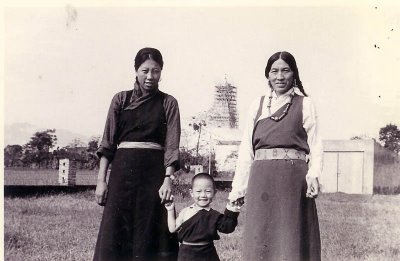 Last night was the yearly Thanksgiving party at Pam and Charles in Kathmandu and present was an old familiar face from the Boudha Stupa - Richard Tenzin. He has recently put up photos from the early days of the rockandrollraj under http://dutchbob.com/on the web, and among his pic I found this one, which you just have to see. The small tulku has his mother Chimey to the right and to his left is his grandmother, the consort of Dilgo Khyentse Rinpoche. The caption said "from the spring 1969" and you can see the stupa being repaired in the background.
Last night was the yearly Thanksgiving party at Pam and Charles in Kathmandu and present was an old familiar face from the Boudha Stupa - Richard Tenzin. He has recently put up photos from the early days of the rockandrollraj under http://dutchbob.com/on the web, and among his pic I found this one, which you just have to see. The small tulku has his mother Chimey to the right and to his left is his grandmother, the consort of Dilgo Khyentse Rinpoche. The caption said "from the spring 1969" and you can see the stupa being repaired in the background.
Thursday, November 24, 2005
Dilgo Khyentse with lamas in Boudhanath
 Graham Sustein - a student of Tulku Urgyen Rinpoche - recently handed me this early photo of Dilgo Khyentse flanked Dabzang Rinpoche and Trulshik Rinpoche. Standing behind his left shoulder is the Rinpoche of Tengpoche Gompa. I'm not sure of the other lamas, so you are welcome to mention if you know them.
Graham Sustein - a student of Tulku Urgyen Rinpoche - recently handed me this early photo of Dilgo Khyentse flanked Dabzang Rinpoche and Trulshik Rinpoche. Standing behind his left shoulder is the Rinpoche of Tengpoche Gompa. I'm not sure of the other lamas, so you are welcome to mention if you know them.
Monday, November 21, 2005
Heart Shrine Relic Tour
In Blazing Splendor, you often read about ringsel, relic-pills left behind in the ashes of great masters. Now some of these relics are touring the world and you can pay respect to them at various places.
PS. Lama Zopa Rinpoche is also a good friend of Chokyi Nyima Rinpoche.
The Maitreya Project Heart Shrine relics have been donated to and collected by Lama Zopa Rinpoche specifically for placing in the Heart Shrine of the 500ft/152m Maitreya Buddha statue. The statue will be the focus of Maitreya Project's vision of creating spiritual, social and economic benefit during the next millennium.The relics will travel the world until approximately 2010 when they will be placed in the completed 500ft/152m Maitreya Buddha statue. Until then, it is Rinpoche's wish that as many people as possible will have the opportunity of viewing these relics in their local communities.
In March 2001, Lama Zopa Rinpoche, Spiritual Director of Maitreya Project, released this rare and precious collection of Buddhist relics for worldwide exhibition. Since then, these sacred relics have been displayed at temples, meditation centres, and other public locations all over the world.
The collection is truly extraordinary. There are many relics of Shakyamuni Buddha and of the Buddha's well-known disciples - Maudgalyayana, Ananda and Sariputra -as well as relics of many other saints and spiritual masters from the Chinese, Indian and Tibetan traditions.
Many living Buddhist masters from a number of traditions and countries, including Burma, Indonesia, Thailand, Tibet and Taiwan, have donated relics to be placed in the Heart Shrine of the Maitreya Project statue, including relics of Shakyamuni Buddha which were offered by His Holiness the Dalai Lama.
The relics are mainly pearl-like 'beads' collected from the ashes of spiritual masters after their cremation. There are also Buddhist artifacts in the collection.
Some of the relics were salvaged from statues in Tibet where they had been enshrined for thousands of years before the Communist occupation in 1959, other relics were donated by museums and monasteries. Lama Zopa Rinpoche has checked very carefully that the relics are genuine before displaying them.
The Heart Shrine Relic Tour exhibitions are open to the public and are free, giving everyone the rare opportunity to be in the presence of such priceless holy objects.
If you are interested in your community sharing in the precious opportunity to view this collection of relics, then please contact us for more details.
http://www.pbs.org/wnet/religionandethics/week711/feature.html
PS. Lama Zopa Rinpoche is also a good friend of Chokyi Nyima Rinpoche.
The Maitreya Project Heart Shrine relics have been donated to and collected by Lama Zopa Rinpoche specifically for placing in the Heart Shrine of the 500ft/152m Maitreya Buddha statue. The statue will be the focus of Maitreya Project's vision of creating spiritual, social and economic benefit during the next millennium.The relics will travel the world until approximately 2010 when they will be placed in the completed 500ft/152m Maitreya Buddha statue. Until then, it is Rinpoche's wish that as many people as possible will have the opportunity of viewing these relics in their local communities.
In March 2001, Lama Zopa Rinpoche, Spiritual Director of Maitreya Project, released this rare and precious collection of Buddhist relics for worldwide exhibition. Since then, these sacred relics have been displayed at temples, meditation centres, and other public locations all over the world.
The collection is truly extraordinary. There are many relics of Shakyamuni Buddha and of the Buddha's well-known disciples - Maudgalyayana, Ananda and Sariputra -as well as relics of many other saints and spiritual masters from the Chinese, Indian and Tibetan traditions.
Many living Buddhist masters from a number of traditions and countries, including Burma, Indonesia, Thailand, Tibet and Taiwan, have donated relics to be placed in the Heart Shrine of the Maitreya Project statue, including relics of Shakyamuni Buddha which were offered by His Holiness the Dalai Lama.
The relics are mainly pearl-like 'beads' collected from the ashes of spiritual masters after their cremation. There are also Buddhist artifacts in the collection.
Some of the relics were salvaged from statues in Tibet where they had been enshrined for thousands of years before the Communist occupation in 1959, other relics were donated by museums and monasteries. Lama Zopa Rinpoche has checked very carefully that the relics are genuine before displaying them.
The Heart Shrine Relic Tour exhibitions are open to the public and are free, giving everyone the rare opportunity to be in the presence of such priceless holy objects.
If you are interested in your community sharing in the precious opportunity to view this collection of relics, then please contact us for more details.
http://www.pbs.org/wnet/religionandethics/week711/feature.html
Saturday, November 19, 2005
Patrul Rinpoche
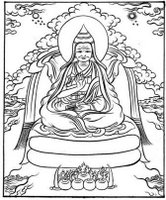
Various of Tulku Urgyen's relatives had great devotion for Patrul Rinpoche and there are various tales about the great Patrul in Blazing Splendor. The following poem by him, though not in the book, is so good i can't help but put it up here.
ADVICE FROM ME TO MYSELF
Vajrasattva, sole deity, Master,
You sit on a full-moon lotus-cushion of white light
In the hundred-petalled full bloom of youth.
Think of me, Vajrasattva,
You who remain unmoved within the manifest display
That is Mahamudra, pure bliss-emptiness.
Listen up, old bad-karma Patrul,
You dweller-in-distraction.
For ages now you've been
Beguiled, entranced, and fooled by appearances.
Are you aware of that? Are you?
Right this very instant, when you're
Under the spell of mistaken perception
You've got to watch out.
Don't let yourself get carried away by this fake and empty life.
Your mind is spinning around
About carrying out a lot of useless projects:
It's a waste! Give it up!
Thinking about the hundred plans you want to accomplish,
With never enough time to finish them,
Just weighs down your mind.
You're completely distracted
By all these projects, which never come to an end,
But keep spreading out more, like ripples in water.
Don't be a fool: for once, just sit tight.
Listening to the teachings—you've already heard hundreds of teachings,
But when you haven't grasped the meaning of even one teaching,
What's the point of more listening?
Reflecting on the teachings—even though you've listened,
If the teachings aren't coming to mind when needed,
What's the point of more reflection? None.
Meditating according to the teachings—
If your meditation practice still isn't curing
The obscuring states of mind—forget about it!
You've added up just how many mantras you've done—
But you aren't accomplishing the kyerim visualizatiion.
You may get the forms of deities nice and clear—
But you're not putting an end to subject and object.
You may tame what appear to be evil spirits and ghosts,
But you're not training the stream of your own mind.
Your four fine sessions of sadhana practice,
So meticulously arranged—
Forget about them.
When you're in a good mood,
Your practice seems to have lots of clarity—
But you just can't relax into it.
When you're depressed,
Your practice is stable enough
But there's no brilliance to it.
As for awareness,
You try to force yourself into a rigpa-like state,
As if stabbing a stake into a target!
When those yogic positions and gazes keep your mind stable
Only by keeping mind tethered—
Forget about them!
Giving high-sounding lectures
Doesn't do your mind-stream any good.
The path of analytical reasoning is precise and acute—
But it's just more delusion, good for nothing goat-shit.
The oral instructions are very profound
But not if you don't put them into practice.
Reading over and over those dharma texts
That just occupy your mind and make your eyes sore—
Forget about it!
You beat your little damaru drum—ting, ting—
And your audience thinks it's charming to hear.
You're reciting words about offering up your body,
But you still haven't stopped holding it dear.
You're making your little cymbals go cling, cling—
Without keeping the ultimate purpose in mind.
All this dharma-practice equipment
That seems so attractive—
Forget about it!
Right now, those students are all studying so very hard,
But in the end, they can't keep it up.
Today, they seem to get the idea,
But later on, there's not a trace left.
Even if one of them manages to learn a little,
He rarely applies his "learning" to his own conduct.
Those elegant dharma disciples—
Forget about them!
This year, he really cares about you,
Next year, it's not like that.
At first, he seems modest,
Then he grows exalted and pompous.
The more you nurture and cherish him,
The more distant he grows.
These dear friends
Who show such smiling faces to begin with—
Forget about them!
Her smile seems so full of joy—
But who knows if that's really the case?
One time, it's pure pleasure,
Then it's nine months of mental pain.
It might be fine for a month,
But sooner or later, there's trouble.
People teasing; your mind embroiled—
Your lady-friend—
Forget about her!
These endless rounds of conversation
Are just attachment and aversion—
It's just more goat-shit, good for nothing at all.
At the time it seems marvellously entertaining,
But really, you're just spreading around stories about other people's mistakes.
Your audience seems to be listening politely,
But then they grow embarrassed for you.
Useless talk that just make you thirsty—
Forget about it!
Giving teachings on meditation texts
Without yourself having
Gained actual experience through practice,
Is like reciting a dance-manual out loud
And thinking that's the same as actually dancing.
People may be listening to you with devotion,
But it just isn't the real thing.
Sooner or later, when your own actions
Contradict the teachings, you'll feel ashamed.
Just mouthing the words,
Giving dharma explanations that sound so eloquent—
Forget about it!
When you don't have a text, you long for it;
Then when you've finally gotten it, you hardly look at it.
The number of pages seems few enough,
But it's a bit hard to find time to copy them all.
Even if you copied down all the dharma texts on earth,
You wouldn't be satisfied.
Copying down texts is a waste of time
(Unless you get paid)—
So forget about it!
Today, they're happy as clams—
Tomorrow, they're furious.
With all their black moods and white moods,
People are never satisfied.
Or even if they're nice enough,
They may not come through when you really need them,
Disappointing you even more.
All this politeness, keeping up a
Courteous demeanor—
Forget about it!
Worldly and religious work
Is the province of gentlemen.
Patrul, old boy—that's not for you.
Haven't you noticed what always happens?
An old bull, once you've gone to the trouble of borrowing him for his services,
Seems to have absolutely no desire left in him at all—
(Except to go back to sleep).
Be like that—desireless.
Just sleep, eat, piss, shit.
There's nothing else in life that has to be done.
Don't get involved with other things:
They're not the point.
Keep a low profile,
Sleep.
In the triple universe
When you're lower than your company
You should take the low seat.
Should you happen to be the superior one,
Don't get arrogant.
There's no absolute need to have close friends;
You're better off just keeping to yourself.
When you're without any worldly or religious obligations,
Don't keep on longing to acquire some!
If you let go of everything—
Everything, everything—
That's the real point!
This advice was written by the practitioner Trime Lodro (Patrul Rinpoche) for his intimate friend Ahu Shri (Patrul Rinpoche), in order to give advice that is tailored exactly to his capacities.
This advice should be put into practice.
Even though you don't know how to practice, just let go of everything—that's what I really want to say. Even though you aren't able to succeed in your dharma practice. don't get angry.
May it be virtuous.
Patrul Rinpoche (1808-1887) was the wandering turn-of-the-century Dzogchen master of Eastern Tibet, beloved by the people. He was renowned as the enlightened vagabond.
Translation by Constance Wilkinson
Friday, November 18, 2005
Lamas from the latest three-year retreat at the Asura Cave Temple
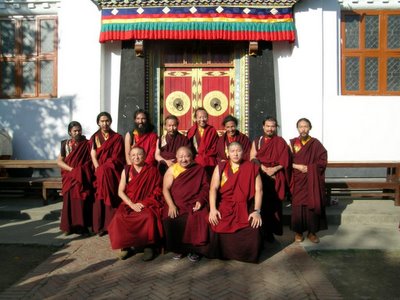 Monks with an earnest desire to devote themselves full-time to spiritual practice may, with the abbot's permission, set aside their academic studies and withdraw to the monastery's retreat center at the Asura Cave Temple in Pharping . In quiet and solitude, they may engage in either short retreats of a few weeks or undertake the traditional 3-year intensive meditation and practice retreat. Presently, a group of eight monks concluded a three-year retreat at the monastery's retreat center in Pharping and returnrd to the main monastery early this spring. The "big black beard" is lama Tenzin, right now teaching at Gomde in Denmark after a long visit in Gomde Austria/Germany.
Monks with an earnest desire to devote themselves full-time to spiritual practice may, with the abbot's permission, set aside their academic studies and withdraw to the monastery's retreat center at the Asura Cave Temple in Pharping . In quiet and solitude, they may engage in either short retreats of a few weeks or undertake the traditional 3-year intensive meditation and practice retreat. Presently, a group of eight monks concluded a three-year retreat at the monastery's retreat center in Pharping and returnrd to the main monastery early this spring. The "big black beard" is lama Tenzin, right now teaching at Gomde in Denmark after a long visit in Gomde Austria/Germany.These days, a new group is preparing to go into retreat - continuing the tradition of Tulku Urgyen Rinpoche and his sons.
Tuesday, November 15, 2005
Atisha's timeless teachings

Tulku Urgyen Rinpoche often quoted Atisha, the great master of the Kadam tradition, and here are some of these precious pieces of advice, from Rainbow Painting:
[picture of Atisha that "looked like him"]
Now I would like to explain three pieces of advice given by Atisha, called the Three Vajras. For a very, very, very long time, we have been roaming throughout samsaric existence from one life to the next. We have died and been reborn and died again, almost endlessly. It is as if we are moving through a huge ocean. The Buddha said, “Samsaric existence is like an endless ocean of sorrow.” Notice he did not say it was an ocean of bliss and happiness: samsara is always called the ‘ocean of suffering,’ never the ‘ocean of bliss’.
If we acknowledge this fact and have faith in it, if we truly desire to be free from this suffering, who can make us free? It’s not the ruler of the country we inhabit, nor our father or mother, our friends, our servants, our fame, or our wealth — none of this can free us from deluded samsaric existence. Only the spiritual endeavors we personally engage in can do so. Once we understand this, we should not let ourselves be dissuaded or falter from that path. So the first advice from Atisha is “Place before you the unshakable vajra of no dissuasion.”
To place before you the vajra of no dissuasion means: do not let anyone — no matter who they are, not even your spiritual teacher — discourage you from practicing the Dharma. A true master who wants you to be free will never say, “Do not pursue the Dharma.” So, the very first step on the spiritual path is to form the unshakable attitude, “I will let no one and nothing dissuade me from practicing the Dharma.” If your teacher tells you, “Do not follow your spiritual inclination,” you have probably made a mistake in choosing that guru.
Similarly, do not let anyone bribe or threaten you to make you not engage in spirituality. Someone may say, “I will offer you half the wealth of this world if you promise not to practice the Dharma any more. Just give up spirituality, and I furnish the money.” We should not let this kind of inducement tempt us. On the other hand, someone might threaten you, pointing a gun at your chest and say, “I will pull the trigger unless you promise to abandon all religious endeavors!” With your mouth, you should of course say, “Yes, I will give it up,” but from inside, from the core of your heart, you most definitely should not agree.
There is a less dramatic and more immediately practical application of this point, which is the reason I bring this up. We often hear the saying, ‘appearances are seductive, and mind is fickle’. Beguiling appearances means that when we see beautiful forms, hear pleasant sounds, smell sweet fragrances, eat delicious food, and feel soft textures touching our body, our mind is immediately attracted. These pleasant objects capture our attention and hold it. On the other hand, when we encounter what is unpleasant — ugly forms, harsh sounds, foul odors, disgusting tastes and rough textures —we feel repelled, maybe even aggressive. Dualistic mind is fundamentally unstable in this respect. The type of attention that is easily captivated or turned off is inherently unsteady. When this normal, unstable and fickle state of mind meets with an enticing phenomenon, it gets carried away. To avoid being constantly carried away, we need to make a firm, unshakable resolve. This is the first of the three points: lord Atisha tells us to make a firm decision, to “place before you the vajra of no dissuasion.”
The second of the Three Vajras is, “Place behind you the vajra of no shame.” When we first take up Dharma practice, we feel a strong wish to be free. We want to renounce further involvement in samsaric states through spirituality. Yet there is a common saying in Tibet: “The new meditator gives away gold, while the old meditator hoards his worn-out shoe soles.” In other words, in the beginning we have the feeling that nothing in this world really matters; we can easily give it all away, thinking, “I am not attached to anything!” Then slowly, two or three years later, we start to become jaded and numb. Even useless old shoe soles take on a new importance. Perhaps we think, “These can be cut up and used as tethers to tie the yaks together.” We start holding on to things, planing all sorts of later uses for them.
To place the vajra of no shame behind you concerns as well the impression we make on ourselves and other people. For example, when people know that an individual has stepped onto the spiritual path, there is an accompanying responsibility. If later on he or she turns back and gives it up, that action destroys the pure perception in others and may even ruin the Dharma for them. Thus, it is better to begin slowly and progress gradually on the path than to start out brilliantly and later become jaded and insensitive.
We should be like a mountain deer who has caught its foot in a trap. When it manages to yank its foot loose it will one-pointedly dart off to an unpeopled place. It is best that we adopt this kind of attitude. Then, in this very body and lifetime, we can abandon all attachment to our homeland and personal links. Living in unknown places, we can be like a child of the mountains. In this way, both ourselves and others will benefit. Others will see that the teachings work, and will gain the assurance that practice makes it possible to leave behind samsara in this very life and attain some accomplishment. Therefore, it is important to make up our mind at the outset, placing behind ourselves the vajra of no shame. Then later on we will not feel any regret for what we have done.
The third vajra is “Keep company with the vajra of pure wisdom.” Here, the purity of wisdom referred to is that of original wakefulness. This is our buddha nature, the enlightened essence, also called rangjung yeshe, self-existing wakefulness. We should first recognize this, decide upon it and gain confidence in our ability to liberate all thought states. After recognizing, we train in the strength of that recognition, until finally we attain stability. Making the decision to do so is the third vajra — “Keep company with the vajra of pure wisdom.” The ‘vajra of pure wisdom’ is the self-existing wakefulness that is always with us because it is our nature. To form the resolve, “I will recognize my own nature as it is!” is the last of the Three Vajras.
There is another series of Atisha’s sayings called the ‘Four Aims’. The first is “Aim your mind at the Dharma.” That means your final aim should be directed at what is true and meaningful rather than at mundane attainment. When we direct our aim toward the Dharma, we can attain liberation and enlightenment; but if we aim at mundane achievements, there is no way in the world we can reach liberation or enlightenment.
Atisha also said, “Aim your Dharma practice at simple living,” not great wealth. It is easier to pursue the teachings if we are simple practitioners. If we have accumulated great wealth before we begin to practice the Dharma, we feel we have to maintain a certain standard of living. It requires incredible effort to increase our wealth, to guard our assets, to make sure they are not depleted. There is much worry and involvement in that; so, it’s best to aim your practice at living simply.
The third aim is “Aim at simple living for your entire life,” not just for a short while. Do not think, “All right, I will practice Dharma as a simple practitioner for a little while and then later on I will make a break-through and become rich and important.” Do not think this way. Instead, aim at remaining a simple practitioner for your entire life, until the time of death.
Finally, Atisha said, “Aim your death at solitude.” This means decide to die alone and friendless in a retreat hermitage or unpeopled place, without being surrounded by attendants and companions. These were the ‘Four Aims’.
Atisha also told us to “keep a low seat,” meaning a low profile. Don’t strive to be high and important. Wear simple clothing, not fancy expensive garments; wear whatever you come by. Moreover, he said, “Let food, clothing and reputation take the defeat.” For example, when a dispute is settled, one party wins while another loses. Let food, clothing and reputation ‘lose the case’. In other words, do not let your mind become preoccupied with food, clothing, fame and importance.
Atisha moreover said, “Be your own teacher.” Be your own guide. Do not remain in a situation where you must always take orders from others. Live in a way that allows you to rely on yourself. If you can live like this, you have the possibility of being a pure practitioner.
The great master Atisha himself lived by these principles, and achieved great accomplishment. We should try our best to apply as much as we can of his advice.
Monday, November 14, 2005
Chatral Rinpoche & Tulku Urgyen Rinpoche with grandson
Friday, November 04, 2005
A game of pool among sacred mountains

The mountain range in the background is supposed sacred to the five Sisters of Long Life, the Tsering Che-Nga. In the foreground you see a frostcovered platform for playing pool for high stakes, outdoors, under the bluest of the bluest sky. The location: half way between Dechen Ling and Shonda in Nangchen.
First snow at Fortress Peak

At Fortress Peak - the hermitage of Tulku Urgyen Rinppoche and his guru in Nangchen - there are still people in retreat. When the snow falls, the meditators gather the first snow and it is used for cooking and cleaning. Because of the high altitude, this place is perfect for particular types of Dzogchen practice, but it is also very cold. Still, the meditators were all smiles.
Vajra Speech is back in print

The real buddha is the nature of our mind. Right now, our buddha nature is covered by obscurations that we need to purify. We also need to gather the two accumulations of merit and wisdom. A practice in which we think that the buddha is outside of ourselves, while ignoring the buddha within, will, by itself, never bring complete enlightenment. If we expect an external buddha up there in the sky to give us all the common and supreme accomplishments, we are merely placing our hopes in an outer object. The ultimate deity is within our own mind. We attain enlightenment by recognizing our true nature and training in that recognition.
--Tulku Urgyen Rinpoche
http://nabfrog.fatcow.com/store/product661.html
Enacting the grand drama at the Great Stupa
 Back in 1978, Dilgo Khyentse Rinpoche was invited to Nepal to bestow the complete empowerments and reading transmissions for the New Treasures of Chokgyur Lingpa (Chokling Tersar). This invitation had been extended by Tulku Urgyen Rinpoche to ensure the continuation of the lineage for the entire termas of Chokgyur Lingpa at Ka-Nying Shedrub Ling Monastery in Boudhanath, Nepal, to a large group of incarnate masters, ordained and lay practitioners, including reincarnations of Chokgyur Lingpa, Jamyang Khyentse Wangpo, and Jamgon Kongtrül, headed by Trulshik Rinpoche, Shechen Rabjam Rinpoche, Dzongsar Jamyang Khyentse, Chokling Mingyur Dewey Dorje, Chokyi Nyima Rinpoche and Orgyen Tobgyal Rinpoche, Tulku Pema Wangyal and Tulku Jigmey Khyentse, Dzigar Kongtrul Rinpoche, Chagdud Tulku Rinpoche and his son Jigme Norbu Rinpoche, and many many others.
Back in 1978, Dilgo Khyentse Rinpoche was invited to Nepal to bestow the complete empowerments and reading transmissions for the New Treasures of Chokgyur Lingpa (Chokling Tersar). This invitation had been extended by Tulku Urgyen Rinpoche to ensure the continuation of the lineage for the entire termas of Chokgyur Lingpa at Ka-Nying Shedrub Ling Monastery in Boudhanath, Nepal, to a large group of incarnate masters, ordained and lay practitioners, including reincarnations of Chokgyur Lingpa, Jamyang Khyentse Wangpo, and Jamgon Kongtrül, headed by Trulshik Rinpoche, Shechen Rabjam Rinpoche, Dzongsar Jamyang Khyentse, Chokling Mingyur Dewey Dorje, Chokyi Nyima Rinpoche and Orgyen Tobgyal Rinpoche, Tulku Pema Wangyal and Tulku Jigmey Khyentse, Dzigar Kongtrul Rinpoche, Chagdud Tulku Rinpoche and his son Jigme Norbu Rinpoche, and many many others.At the end, an auspicious drama was performed to commemmorate how Buddhism was established at Samye in Tibet, showing the profound link between the wishes made in the past by Padmasambhava, King Trisong Deutsen and Shantarakshita. (I think you can see who those three actors were).
Wednesday, November 02, 2005
Two short reviews from Bernie Simon
Bernie Simon author's The Careless Hand and recently mentions Blazing Splendor:
http://carelesshand.net/weblog.pl/dharma/blazing_splendor_review.html
&
http://carelesshand.net/weblog.pl/dharma/blazing_review_part_two.html
http://carelesshand.net/weblog.pl/dharma/blazing_splendor_review.html
&
http://carelesshand.net/weblog.pl/dharma/blazing_review_part_two.html
Tuesday, November 01, 2005
Wide open space of wisdom
Wide open space of wisdom
Please read this piece by Dilgo Khyentse Rinpoche on buddha nature. He was a very close friend of Tulku Urgyen Rinpoche and the teacher of his four sons: One of the greatest masters of our times.
Please read this piece by Dilgo Khyentse Rinpoche on buddha nature. He was a very close friend of Tulku Urgyen Rinpoche and the teacher of his four sons: One of the greatest masters of our times.
Monday, October 31, 2005
Early picture of Tulku Urgyen Rinpoche in the Ipoh Cave
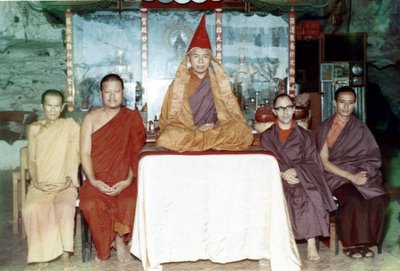 Earlier in this weblog it was brought up that Tulku Urgyen Rinpoche may have been the first Tibetan Lama to visit Southeast Asia. At that time I asked for some photos and Anne sent this and two other photos. The large Chinese monk to Rinpoche's right is Khoo Poh Kong, and to his left is the British monk Lodro Thaye.
Earlier in this weblog it was brought up that Tulku Urgyen Rinpoche may have been the first Tibetan Lama to visit Southeast Asia. At that time I asked for some photos and Anne sent this and two other photos. The large Chinese monk to Rinpoche's right is Khoo Poh Kong, and to his left is the British monk Lodro Thaye.Dear Erik,
I managed to get hold of some the pics taken during his visit to Ipoh. They were in possesion of Tulku Urgyen Rinpoche's students. Another man worth mentioning is Khoo Poh Kong who were instrumental in the organising the event of Tulku Urgyen Rinpoche's first visit to Ipoh.
Anne of Ipoh
Friday, October 28, 2005
New Dimensions Radio highlights Blazing Splendor
 Michael Toms and his wife Justine recently invited us -- Daniel Goleman, Marcia Binder Schmidt and Erik Pema Kunsang -- to speak freely about a topic close to our hearts and it was a great pleasure to discuss Tulku Urgyen Rinpoche's life and lineage, his teachings and the impact he has had on the western world. The one hour recording will be aired internationally.
Michael Toms and his wife Justine recently invited us -- Daniel Goleman, Marcia Binder Schmidt and Erik Pema Kunsang -- to speak freely about a topic close to our hearts and it was a great pleasure to discuss Tulku Urgyen Rinpoche's life and lineage, his teachings and the impact he has had on the western world. The one hour recording will be aired internationally.For air times check radio listings on their website: http://www.newdimensions.org/ An additional small interview will also be available on their website.
It was fascinating to see the library of people the Toms have interviewed over the last decades, including the 16th Karmapa, Kalu Rinpoche, Buckminster Fuller, and many many others. We wish the Toms a long life and thank them for their hospitality.
Friday, October 21, 2005
view from Lachab - Tulku Urgyen Rinpoche's monastery in Nangchen
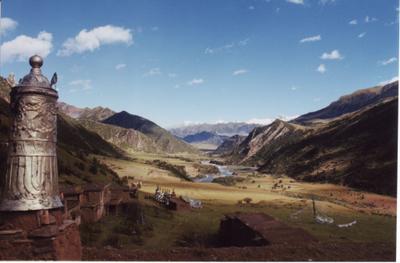 This picture was taken from the roof of Lachab monastery, the seat of the Ngaktrin tulkus and the young Tulku Urgyen Rinpoche, before leaving his homeland and establishing Ka-Nying Shedrub Ling in Nepal. This far-away little Gompa is located in Nangchen, an ancient kingdom between Tibet and Derge. The present abbot Tsewang Dechen Rinpoche told me the following story:
This picture was taken from the roof of Lachab monastery, the seat of the Ngaktrin tulkus and the young Tulku Urgyen Rinpoche, before leaving his homeland and establishing Ka-Nying Shedrub Ling in Nepal. This far-away little Gompa is located in Nangchen, an ancient kingdom between Tibet and Derge. The present abbot Tsewang Dechen Rinpoche told me the following story:It was founded by Ngawang Trinley, the oldest of three sons in the Tsangsar clan. He received monk ordination from the eleventh Karmapa, Yeshe Dorje (1676-1702), and as given the command to build the monastery Lachab Gompa. "It will bring great benefit to beings," the Karmapa said. Ngawang Trinley belonged mainly to the Barom Kagyu lineage, but he also practiced teachings from the Karma Kagyu and Nyingma. Barom Kagyu teachings he received from Tsangsar Rinchen Lhundrub and the Karma Kagyu teachings from the Karmapa Yeshe Dorje. Ngawang Trinley became a great lama who upheld and spread the Dharma. He was famed as being an incarnation of Gonpo Chakshipa, a wisdom protector. He died at an age above 60. The monastery he founded is named Lachab Jangchub Nordzin Choling and is situated in the Nangchen area of Kham. It lies in the nowadays Chinese province of Tso-ngon, Blue Lake, about 200 kilometers south of Nangchen Dzong.
Tuesday, October 18, 2005
Visiting the Vajra Throne, Bodhgaya
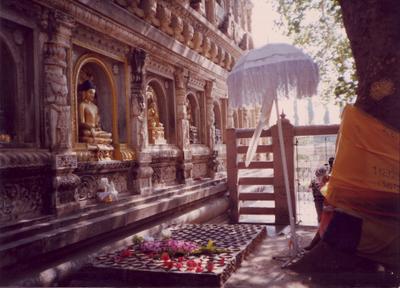
After I finished my retreat I was able to go on several pilgrimages. First, I visited Bodhgaya, one of the most sacred places in this world. As sutras tell us, the vajra throne in Bodhgaya is the site where the one thousand buddhas of this eon awaken to complete enlightenment. Samten Gyatso once told me that all who visit Bodhgaya just once in their lifetime have not wasted their life and can die without regret. With that in mind, and not wanting to die without having seen it, I headed off for Bodhgaya soon after arriving in Sikkim. I was looking forward to making prayers and pure wishes at that sacred place, though I didn’t get to stay long on that first visit.
There is a relative and an ultimate meaning of the term vajra throne. The ultimate is the awakened state of primordial purity, which is the real location for attaining enlightenment. The vajra throne in Bodhgaya is an external version of the inner throne of basic space. In Kham, everyone had heard that when the deceased’s spirit flounders through the bardo, there are only two places it cannot choose to go: the mother’s womb and the vajra throne. But Samten Gyatso once told me, “It’s not the throne in Bodhgaya, it’s the vajra throne of inner basic space, the awakened state of primordial purity. After conception, you can’t come and go from the mother’s womb. You can only go in once, then you stick like a fly in glue and the spirit begins to be enveloped in a body composed of the aggregates, elements, and sense bases, from which there is no escape until the death of that rebirth.”
--Tulku Urgyen Rinpoche, from Blazing Splendor
photo: Graham Sunstein
Sunday, October 16, 2005
Kyabje Dilgo Khyentse and Khamtrul Rinpoche in Gangtok
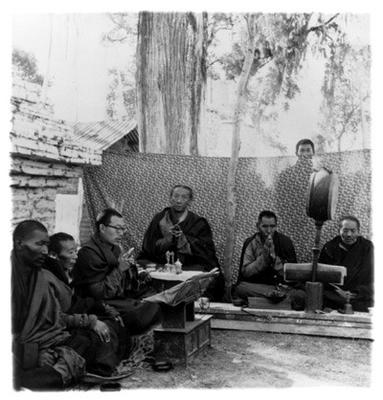 This picture is on of the earliest photos taken after Kyabje Dilgo Khyentse left Tibet. He is seated with Khamtrul Tenpey Nyima, the head of the Drukpa Kagyu monastery that was to be built in Tashi Jong, Himachal Pradesh, on his left left. I was told that it was taken in Gangtok, after the passing of his Dzongsar Khyentse Chokyi Lodro, one of his two principal gurus.
This picture is on of the earliest photos taken after Kyabje Dilgo Khyentse left Tibet. He is seated with Khamtrul Tenpey Nyima, the head of the Drukpa Kagyu monastery that was to be built in Tashi Jong, Himachal Pradesh, on his left left. I was told that it was taken in Gangtok, after the passing of his Dzongsar Khyentse Chokyi Lodro, one of his two principal gurus.
Saturday, October 15, 2005
Tulku Urgyen's Great-Grandfather
 Tulku Urgyen's Great-Grandfather Chokgyur Lingpa was a major revealer of hidden treasures. His collected works comprise more than 40 volumes and is known as Chokling Tersar, the New Treasures of Chokgyur Lingpa. He was both teacher and disciple of Jamyang Khyentse and Jamgon Kongtrul, and these three masters are famed for having initiated the nonsectarian Rimey movement in the late 19th century.
Tulku Urgyen's Great-Grandfather Chokgyur Lingpa was a major revealer of hidden treasures. His collected works comprise more than 40 volumes and is known as Chokling Tersar, the New Treasures of Chokgyur Lingpa. He was both teacher and disciple of Jamyang Khyentse and Jamgon Kongtrul, and these three masters are famed for having initiated the nonsectarian Rimey movement in the late 19th century.Read about Chokgyur Lingpa and his termas, spoken by Orgyen Tobgyal Rinpoche: http://www.rangjung.com/authors/Chokgyur_Lingpa_and_his_termas.htm
Friday, October 14, 2005
Yongey Mingyur Rinpoche - the youngest son
 Tulku Urgyen Rinpoche's sixth son grew up under the tutelage of Situ Rinpoche in Bir and began a three retreat at age fourteen. Immediately after he became the drubpon, retreat master for the next retreat. He has since completed shedra, monastic college.
Tulku Urgyen Rinpoche's sixth son grew up under the tutelage of Situ Rinpoche in Bir and began a three retreat at age fourteen. Immediately after he became the drubpon, retreat master for the next retreat. He has since completed shedra, monastic college.For more details of his life, see http://www.rangjung.com/authors/mingyur_rinpoche.htm
His teaching schedule is posted on: http://mingyur.org/
Wednesday, October 12, 2005
Tsoknyi Rinpoche, the fifth son
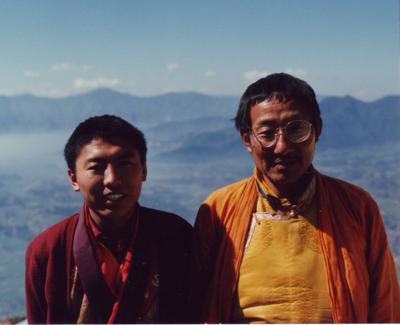
Tulku Urgyen Rinpoche's fifth son is also a reincarnation of a lama related to him from his homeland. In Blazing Splendor we find the moving story of the first Tsoknyi (who grew up in the same monastery --Tsechu -- as Chokyur Lingpa) and whose disciple later founder all the nunneries.
Here is a photo of Tsoknyi together with one of his teachers, Adeu Rinpoche, who is the abbot of Tsechu Gompa in Nangchen.
More details at: http://www.rangjung.com/authors/tsoknyi.htm
You can find his teaching schedule on: www.pundarika.org
Tuesday, October 11, 2005
Mahasiddha.com: Fear and loathing in Tibet- Part One.
Mahasiddha.com: Fear and loathing in Tibet- Part One.
You may enjoy reading about Gesar. Shechen Kongtrul was a close friend of Tulku Urgyen, as you can read in Blazing Splendor.
You may enjoy reading about Gesar. Shechen Kongtrul was a close friend of Tulku Urgyen, as you can read in Blazing Splendor.
Tenpa La, the third son
 Tulku Urgyen Rinpoche's third son was born to a close attendent of the Tsurphu Khandro, the great dakini of Tsurphu, and for many years he has worked as the general secretary of Tenga Rinpoche of Benchen monastery at Swayambhu, a great lama of the Kagyu lineage whose monastery in Tulku Urgyen's homeland . This monastery, Benchen, is also the seat of the illustrious Sangye Nyenpa, Traleg, and Chimey tulkus.
Tulku Urgyen Rinpoche's third son was born to a close attendent of the Tsurphu Khandro, the great dakini of Tsurphu, and for many years he has worked as the general secretary of Tenga Rinpoche of Benchen monastery at Swayambhu, a great lama of the Kagyu lineage whose monastery in Tulku Urgyen's homeland . This monastery, Benchen, is also the seat of the illustrious Sangye Nyenpa, Traleg, and Chimey tulkus.More about Tenga Rinpoche: http://www.rangjung.com/authors/Tenga_Rinpoche.htm
Tulku Urgyen's fourth son is Orgyen Jigmey. He was left behind in Tibet under the cultural revolution and has since decided to remain a layman.
Monday, October 10, 2005
The Family Tree
Wouldn't it be wonderful to have a really clear picture of how all the people in Tulku Urgyen's family were related? One that shows the three children of the great treasure revealer Chokgyur Lingpa, one of which was Tulku Urgyen's grandmother, the lady who told him so many of these amazing stories when he was a small child? And how the family branched out from her through her son Chimey Dorje, the Immortal Vajra, a rogue turned siddha, the grandfather of Chokyi Nyima Rinpoche?
Luckily Ayshen Delemen has made one and you can download it right here: http://www.rangjung.com/blazing/FamilyTree.pdf
Luckily Ayshen Delemen has made one and you can download it right here: http://www.rangjung.com/blazing/FamilyTree.pdf
Saturday, October 08, 2005
Enlightened Poet -- Chokgyur Lingpa
Mingyur Dewey Dorje, the 4th Chokling of Tsikey
 Tulku Urgyen Rinpoche's Second son is an incarnation of Chokgyur Lingpa and was born from Kunsang Dechen, the same mother as Chokyi Nyima Rinpoche. Here he is seen on the balcony of Ka-Nying Shedrub Ling monastery in Boudha, in 1976, blessing a pilgrim from the mountains.
Tulku Urgyen Rinpoche's Second son is an incarnation of Chokgyur Lingpa and was born from Kunsang Dechen, the same mother as Chokyi Nyima Rinpoche. Here he is seen on the balcony of Ka-Nying Shedrub Ling monastery in Boudha, in 1976, blessing a pilgrim from the mountains. For some brief biographical details, see http://www.rangjung.com/authors/Tsikey_Chokling_4th_Gyurmey_Dewey_Dorje.htm
Friday, October 07, 2005
Tulku Urgyen Rinpoche's oldest son
 During the recent tour of reading loud from Blazing Splendor, some questions have been raised repeatedly: did Tulku Urgyen have children who teach? Who are they? Where do they live?
During the recent tour of reading loud from Blazing Splendor, some questions have been raised repeatedly: did Tulku Urgyen have children who teach? Who are they? Where do they live?So this weblog can of course serve as a way to introduce them -- one after the other.
The first-born was Chokyi Nyima Rinpoche and he is the abbot of the the "Big White" monastery in Boudha, five minutes behind the Great Stupa. Almost all the guidebooks to Nepal mention his famous Saturday Talks, and he is been teaching people from all over the world since the early 1970s. For more details of his activities, see www.shedrub.org and his brief biography at http://www.rangjung.com/authors/chokyi_nyima_rinpoche.htm
Wednesday, October 05, 2005
The road to Bodhgaya
The road to Bodhgaya is not level;
there are mountain passes, valleys, rivers, precipices and so forth.
No matter what your personal road is like,
do not lose courage,
but repeatedly relax loosely in nondual awareness.
If we practice like this then one day,
we will arrive in Bodhgaya,
which means we will attain enlightenment.
If we do not set out on the road, we will never arrive.
there are mountain passes, valleys, rivers, precipices and so forth.
No matter what your personal road is like,
do not lose courage,
but repeatedly relax loosely in nondual awareness.
If we practice like this then one day,
we will arrive in Bodhgaya,
which means we will attain enlightenment.
If we do not set out on the road, we will never arrive.
-- from the words of Tulku Urgyen Rinpoche
Tuesday, October 04, 2005
The pervasiveness of the Dharma in Tibet
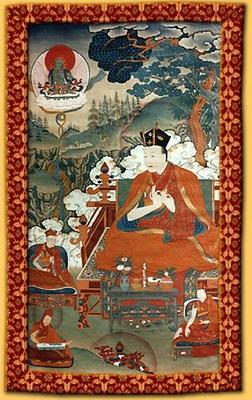
Before continuing with my tale, I want to emphasize that the Dharma was remarkably widespread throughout the snowy land of Tibet. It so permeated our society that even small children didn’t have to deliberately study prayers such as the supplication to the Lotus-Born master. They would learn how to chant it just by growing up in this Buddhist environment and hearing it over and over.
Children’s games reflected this atmosphere and we often played at building monasteries. Groups of us kids would pile up mud and stones, under my supervision, and we managed to make some small “temples” in which we would play “lama.” Sometimes these games went on from early morning until sunset.
Aside from the hermits and vast assemblage of monks and nuns living in the big monasteries, practitioners often stayed together in large encampments, such as the group surrounding Shakya Shri. For instance, the seventh Karmapa never stayed long in one place but moved from one camp to another throughout Tibet. Any offerings he received he would pass along on the spot to the local monasteries.
The seventh Karmapa’s close entourage consisted of at least one thousand monks, who followed along wherever the Karmapa went. The monks and attendants with their horses and yaks were so numerous that not everybody could fit in one place. So they staggered their movements in groups of one hundred, camping at seven or more different places a day’s travel apart, staying a day in each place.
People camped in tiny meditation tents with a single pole, just big enough to sit in. The whole monastic community would stay in such tents, though the master’s tent was typically larger. They were all required to keep the Kagyu tradition of four practice sessions a day, even while traveling. At a designated time, a bell would be rung and they would eat their meal together.
As soon as the meal was completed, according to the tradition, they would recite the Kangyur, the Buddhist canon in one hundred large volumes. As they traveled along, walking in a line across a vast plain, younger monks would distribute separate pages to each of the hundred monks, collecting the pages as they finished. All together they could easily complete all one hundred volumes by the time they reached the next mountain range, each monk reciting just two or three pages from each volume. The whole encampment was so large that, when everyone was together, the monks could recite the whole Kangyur in just an hour. The heap of their used tea leaves was often as tall as a man.
The Karmapa’s caravan was known as “the great encampment that adorns the world,” one of countless examples illustrating how deeply the Dharma was woven into our very existence.
From Blazing Splendor, the memoirs of Tulku Urgyen Rinpoche
Sunday, October 02, 2005
Dzongsar Khyentse Chokyi Lodro
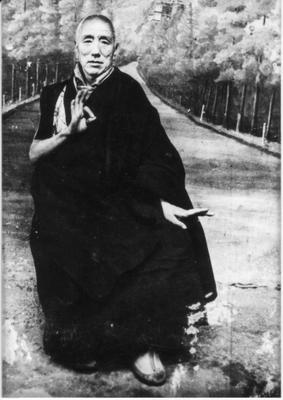 In Blazing Splendor we find so many times a mention of the great master Dzongsar Khyentse Chokyi Lodro that we just have to know more about him. Luckily, the talented young translator Adam Pearcey has translated a rather lengthy biography by Orgyen Tobgyal Rinpoche and made it available online: http://www.lotsawahouse.org/id40.html There is also a shorter version: http://www.rangjung.com/authors/Dzongsar_Khyentse_Chokyi_Lodro.htm
In Blazing Splendor we find so many times a mention of the great master Dzongsar Khyentse Chokyi Lodro that we just have to know more about him. Luckily, the talented young translator Adam Pearcey has translated a rather lengthy biography by Orgyen Tobgyal Rinpoche and made it available online: http://www.lotsawahouse.org/id40.html There is also a shorter version: http://www.rangjung.com/authors/Dzongsar_Khyentse_Chokyi_Lodro.htmThe photo is from Kalimpong, possibly 1958.
Words from Tulku Urgyen Rinpoche
What is really valuable? Our precious human rebirth, this body, given to us by our father and mother. We have all our senses intact, we are intelligent and capable of understanding — it is an incredible advantage, like a wish-fulfilling jewel. Another analogy compares being endowed with a precious human rebirth to arriving on an island where jewels abound. As this is the case, it’s extremely important not to stand around with our hands in our pockets or folded across our chest. This life should be put to use and be taken full advantage of, so that we don’t return empty-handed.
Don’t just take my word for it, but decide for yourselves what is really meaningful to pursue in this life. I am only trying to refresh your memory and clarify what you already know very well. Nonetheless, appearances, what we smell, hear, see, taste, and touch, are seductive. If we allow ourselves to be carried away by our fickle mind, even though we may really want to practice the Dharma, it is somehow postponed. We think, “Well, if not today, I can practice tomorrow or maybe next month, or next year.” Or never. Things don’t occur exactly in accordance with our plans. It is said, “When I was young, I was controlled by others and couldn’t practice the Dharma. When I grew up, I played around and couldn’t practice the Dharma. Now, I’m old and too weak to practice the Dharma. Alas, alas! What shall I do?” Decide for yourselves: are you able to practice the Dharma?
Don’t just take my word for it, but decide for yourselves what is really meaningful to pursue in this life. I am only trying to refresh your memory and clarify what you already know very well. Nonetheless, appearances, what we smell, hear, see, taste, and touch, are seductive. If we allow ourselves to be carried away by our fickle mind, even though we may really want to practice the Dharma, it is somehow postponed. We think, “Well, if not today, I can practice tomorrow or maybe next month, or next year.” Or never. Things don’t occur exactly in accordance with our plans. It is said, “When I was young, I was controlled by others and couldn’t practice the Dharma. When I grew up, I played around and couldn’t practice the Dharma. Now, I’m old and too weak to practice the Dharma. Alas, alas! What shall I do?” Decide for yourselves: are you able to practice the Dharma?
Friday, September 30, 2005
Chatral, Dudjom and Dilgo Khyentse, Rinpoches
Wednesday, September 28, 2005
Rubin Museum of Art September 29 was SOLD OUT
Blazing Splendor Book Reading event on Thursday, September 29, 2005 in New York City at 7:00pm at the Rubin Museum of Art was SOLD OUT
See the film of the reading on October 21, November 25 or 27 - (open to RMA Members only). For more information contact the Rubin Museum of Art at : 212.620.5000 at info@rmanyc.org www.rmanyc.org
Readings from the newly published Memoirs of the Dzogchen Yogi Tulku Urgyen Rinpoche with Sharon Salzberg, Daniel & Tara Goleman, Mingyur Rinpoche, Erik Pema Kunsang, Marcia Binder Schmidt, Michael Tweed and Tom Lesser. Blazing Splendor provides a first-hand glimpse into what actually took place in the last decades of old Tibet, through the eyes of an insider who held little illusion about what was to transpire in his country. The book spans an exceptional period in Tibetan history and provides a telling, up-close look at the treachery of Lhasa politics during this endgame. Tulku Urgyen describes his days as the Karmapa\'s envoy to the Tibetan government and finally how the spiritual greatness that was once Tibet manages to resurrect itself in the world beyond, as he—auguring what was to come—flees Tibet a year before the Dalai Lama himself. A co-presentation with Tricyle, a Buddhist magazine.
See the film of the reading on October 21, November 25 or 27 - (open to RMA Members only). For more information contact the Rubin Museum of Art at : 212.620.5000 at info@rmanyc.org www.rmanyc.org
Readings from the newly published Memoirs of the Dzogchen Yogi Tulku Urgyen Rinpoche with Sharon Salzberg, Daniel & Tara Goleman, Mingyur Rinpoche, Erik Pema Kunsang, Marcia Binder Schmidt, Michael Tweed and Tom Lesser. Blazing Splendor provides a first-hand glimpse into what actually took place in the last decades of old Tibet, through the eyes of an insider who held little illusion about what was to transpire in his country. The book spans an exceptional period in Tibetan history and provides a telling, up-close look at the treachery of Lhasa politics during this endgame. Tulku Urgyen describes his days as the Karmapa\'s envoy to the Tibetan government and finally how the spiritual greatness that was once Tibet manages to resurrect itself in the world beyond, as he—auguring what was to come—flees Tibet a year before the Dalai Lama himself. A co-presentation with Tricyle, a Buddhist magazine.
Monday, September 26, 2005
The Big White Gompa in Boudha, ca 1978
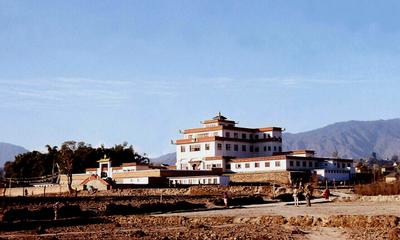 Many of you have been to Boudha and visited the Great Stupa and taken a round of the various monasteries. But where did the lamas come from and how were those monasteries first build? Some of them have fascinating stories behind them.
Many of you have been to Boudha and visited the Great Stupa and taken a round of the various monasteries. But where did the lamas come from and how were those monasteries first build? Some of them have fascinating stories behind them.Some fifty ago (in the mid-1950’s), the 16th Gyalwang Karmapa, Rangjung Rigpey Dorje, gave a command and prophecy to one of his principal gurus, Tulku Urgyen Rinpoche, Dharma Master of Lachab Gompa in Kham: "If you go to Nepal and build a monastery, it will further the Buddhist Doctrine and bring benefit to sentient beings.” In accordance with Karmapa's wish, Tulku Urgyen Rinpoche left his monastery in eastern Tibet and crossed over the Himalayan Mountains into neighboring Nepal where he journeyed in its northern regions. Shortly thereafter, Karmapa placed Tulku Urgyen Rinpoche in charge of Nagi Gompa, a nunnery situated high on the northern slopes of Kathmandu Valley. After settling there, he quickly expanded the nunnery to include a main temple and simple dwellings for about 80 nuns. Early in 1972, Tulku Chokyi Nyima Rinpoche and Chokling Rinpoche joined their parents, Tulku Urgyen Rinpoche and his consort, Kunsang Dechen, in Kathmandu. Until that time, the brothers had been studying since childhood at Rumtek Monastery, seat of His Holiness Karmapa, in Sikkim. Within a short time, Tulku Urgyen Rinpoche and his family began construction of Ka-Nying Shedrub Ling Monastery on spacious farmland just north of the ancient legendary Jarung Khashor Stupa in the village of Boudha Nath. Upon completion of the monastery in 1976, His Majesty King Birendra of Nepal performed the official inauguration, the first time he had performed such a ceremony for a Buddhist monastery. Immediately thereafter, the 16th Gyalwang Karmapa appointed 24-year old Tulku Chokyi Nyima Rinpoche abbot of the new monastery.
This picture and text was sent to me by Shenpen Lhamo. Thanks.
Sunday, September 25, 2005
Lachab - Tulku Urgyen Rinpoche's monastery in Nangchen
 Lachab Jangchub Nordzin Choling was and still is the main monastery of Samten Gyatso and Tulku Urgyen Rinpoche in Nangchen. Even though Tulku Urgyen Rinpoche re-established his seat in Nepal, outside of Kham, the lineage of his guru and his former incarnation is still being carried on in Nanchen. Here is a short story about his former life, Chowang Tulku:
Lachab Jangchub Nordzin Choling was and still is the main monastery of Samten Gyatso and Tulku Urgyen Rinpoche in Nangchen. Even though Tulku Urgyen Rinpoche re-established his seat in Nepal, outside of Kham, the lineage of his guru and his former incarnation is still being carried on in Nanchen. Here is a short story about his former life, Chowang Tulku:Kalpa, Chöwang’s attendant, was quite old when I met him. He had continued his meditation practice, and it seemed to me that he had reached a solid level of experience and realization. Kalpa told me many other interesting stories about Chöwang. They must be true because that old monk never lied.
Tsang-Yang Gyamtso once went up to meet Chöwang Tulku and when Kalpa went in to announce his arrival, Chöwang simply said, “He doesn’t need to see me. There’s nothing he can get from meeting me.” So, the visitor did several circumambulations and left.
Another time, a guest who had traveled quite far came with an offering he had been given to present to Chöwang Tulku—a large brick of expensive Chinese tea. Halfway to Fortress Peak this guest stopped at a river to have a meal and, as he looked at the fine tea, decided to steal half of it.
So he took out his knife and cut it in two. He wrapped one part back up in the white scarf and the rest he hid in his bag, thinking to himself, “The lama doesn’t need more than half, so I’ll just keep the rest.”
When he approached Chöwang Tulku, the guest of course didn’t mention anything about taking some of the tea. As he handed over his offering of tea, he simply said, “This is for you.”
Then he noticed that his knife, which he was especially fond of, was missing. So he said, “Hey, Rinpoche! Could you perform a divination to see if I will find my favorite knife? I lost it somewhere on the way here.”
Without a moment’s hesitation, Chöwang Tulku replied, “Don’t you remember where we divided up the tea, half for you and half for me? Go back and you will find your knife lying right there.”
Hearing this, the man was petrified and began to cry. He apologized, confessing the whole story. Weeping, he prostrated and took out the tea he had stolen.Chöwang Tulku said, “Don’t take it so hard! I don’t need that much tea. It’s fine if you take some home. Take it back there and make yourself some delicious tea. Enjoy it—and tell your family that I gave it to you.”
Thursday, September 22, 2005
Recent holder of the Hearing Lineage
 One of the more outstanding masters in recent times was Khenpo Ngawang Palzang of Khatok, usually known as Khenpo Ngakchung.
One of the more outstanding masters in recent times was Khenpo Ngawang Palzang of Khatok, usually known as Khenpo Ngakchung.Several of Tulku Urgyen Rinpoche’s teachers had studied with this master, but especially Bomta Khenpo (Polo Khenpo Dorje). Here is a story about him from Blazing Splendor:
One day Bomta Khenpo told me, “In my life I have received plenty of teachings on the view and the scriptures of the Great Perfection, as have many others. But I’m one of the rare people who have met both Vimalamitra’s emanation and Vimalamitra in actuality.”
“Please, Rinpoche,” I requested, “tell me the story.”
“Vimalamitra’s emanation is my teacher Khenpo Ngakchung. Once every hundred years, Vimalamitra sends an emanation to Tibet to clarify the innermost essence of the Dzogchen teachings. Paltrul once told his disciple Lungtok of Nyoshul that he didn’t get to meet this emanation of Vimalamitra, but ‘you will probably meet him in your time.’ Lungtok identified his own disciple Khenpo Ngakchung as an unmistaken emanation of Vimalamitra and Khenpo Ngakchung became my root guru.
“When I met Khenpo Ngakchung, I already had a fairly good comprehension of emptiness, but that degree of theoretical learning didn’t satisfy me. I still felt an acute need to clarify every point and gain a thorough understanding, to the fullest degree.
“So I asked for the job of Khenpo’s tea server—not that I was that young at the time, but I thought it would be a good way to get close to the master. Each time I poured him a cup of tea, I whispered a short question and each time I received an answer. That was the only practical way to approach him; otherwise you had to advance to the position of assistant teacher to be allowed to ask questions. For eight years, I held on to my menial chore, serving his tea—and at the end of that time, I couldn’t find a single question that I still needed to ask.”
Later on, I got a chance to ask the Karmapa about Bomta Khenpo’s teacher, “What do you think of Khenpo Ngakchung?”
“Oh, he’s definitely an emanation of Vimalamitra,” he replied in his deep voice.
That settled it.
For more details about the nature of the pointing-out instruction, see: http://www.rangjung.com/authors/tulku_urgyen_rinpoche-interview.htm
Sunday, September 18, 2005
Young Lamas Home School in Dalhousie
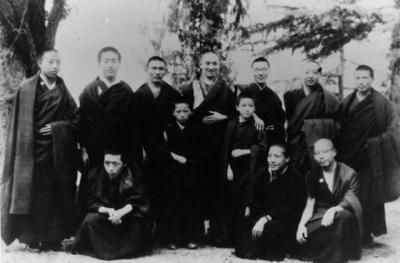
The British woman Frida Bedi arranged in the early 1960s for many of the young tulkus -- recently arriving from Tibet and Kham -- to continue their education in a school in Dalhousie. Standing, third from the right, is Chogyam Trungpa Rinpoche who was one of the teachers at the time. Tulku Urgyen Rinpoche was also asked to send his two sons -- Chokyi Nyima and Chokling who remained for six months before they were summonded by the Karmapa to Rumtek.
If you know any of the other lamas on the picture, please click on "comment" and write them in.
Friday, September 16, 2005
Rare snow at Nagi Gompa
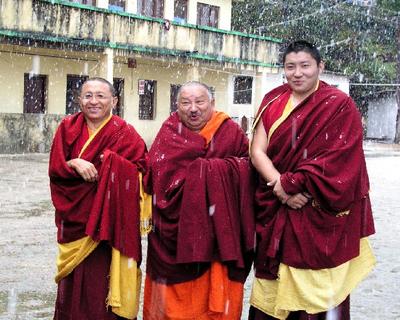 After spending a couple of years in Sikkim and in the mountains of Nepal, Tulku Urgyen Rinpoche was asked by the 16th Karmapa to take residence at Nagi Gompa, situated on the northern slope of the Kathmandu Valley. In those days, the early 1960s, there was no road, and all provisions and building materials were carirried by hand -- a real hermitage. Over the years, a road was laid, and there is now electricity, water in pipes from the spring above to the more than hundred nuns, two centers for three-years retreats, and the main temple where Tulku Urgyen Rinpoche lived until 1996. This photo was taken last year during the yearly Ngakso Drubchen ceremonies, graced by a gentle descent of beautiful snowflakes.
After spending a couple of years in Sikkim and in the mountains of Nepal, Tulku Urgyen Rinpoche was asked by the 16th Karmapa to take residence at Nagi Gompa, situated on the northern slope of the Kathmandu Valley. In those days, the early 1960s, there was no road, and all provisions and building materials were carirried by hand -- a real hermitage. Over the years, a road was laid, and there is now electricity, water in pipes from the spring above to the more than hundred nuns, two centers for three-years retreats, and the main temple where Tulku Urgyen Rinpoche lived until 1996. This photo was taken last year during the yearly Ngakso Drubchen ceremonies, graced by a gentle descent of beautiful snowflakes.
Tuesday, September 13, 2005
Tulku Rabsel Dawa - Brilliant Moon
 Dilgo Khyentse Rinpoche first appears in Blazing Splendor as one of the teachers of Tulku Urgyen's uncle, Tersey Tulku, who received the transmission for the black Vajra Yogini from him. There is also a long, intimate story of Dilgo Khyentse revealing a terma from a scroll with dakini script which Tulku Urgyen had received from his grandmother. Here is en early photo from either Lhasa or Kalimpong.
Dilgo Khyentse Rinpoche first appears in Blazing Splendor as one of the teachers of Tulku Urgyen's uncle, Tersey Tulku, who received the transmission for the black Vajra Yogini from him. There is also a long, intimate story of Dilgo Khyentse revealing a terma from a scroll with dakini script which Tulku Urgyen had received from his grandmother. Here is en early photo from either Lhasa or Kalimpong.Here is a short biography: http://www.shechen.org/sub_teachers_dkr.html
Thursday, September 08, 2005
A talk on the life of Tulku Urgyen Rinpoche in Halifax, Canada
Talk by Erik Pema Kunsang & Marcia Binder Schmidt co-authors of Blazing Spendor: The Memoirs of Tulku Urgyen Rinpoche will give a talk on the life of Tulku Urgyen Rinpoche Friday, September 9 7:00 pm, $10, open to all
Intimate in tone, these personal memoirs recount the influences and experiences that shaped one of the great spiritual teachers of our time. Blazing Splendor is both of spiritual and historical import. Erik Pema Kunsang began translating with Tulku Urgen in 1980. Tulku Urgyen Rinpoche was among Tibetan Buddhism's greatest masters of the 20th century, and was highly instrumental in bringing the practice of Dzogchen (Great Perfection) to the West.
http://www.halifax.shambhala.org/class_details.html#blazing
Intimate in tone, these personal memoirs recount the influences and experiences that shaped one of the great spiritual teachers of our time. Blazing Splendor is both of spiritual and historical import. Erik Pema Kunsang began translating with Tulku Urgen in 1980. Tulku Urgyen Rinpoche was among Tibetan Buddhism's greatest masters of the 20th century, and was highly instrumental in bringing the practice of Dzogchen (Great Perfection) to the West.
http://www.halifax.shambhala.org/class_details.html#blazing
Wednesday, September 07, 2005
Tokden-meditators in Nangchen
 Many of the stories in Blazing Splendor mention the tokden style of meditator in Nangchen. Often they are monks who during long retreats never cut their hair, and then continued to leave it uncut -- perhaps a sign of naturalness. These days, the tradition remains unbroken. Here is one tokden I just had to take a photo of in 2003, and he didn't mind. In Nepal and India, the monks and nuns cut their longs braids after the three-year retreats, as in the retreat centers Tulku Urgyen established at Nagi and Asura.
Many of the stories in Blazing Splendor mention the tokden style of meditator in Nangchen. Often they are monks who during long retreats never cut their hair, and then continued to leave it uncut -- perhaps a sign of naturalness. These days, the tradition remains unbroken. Here is one tokden I just had to take a photo of in 2003, and he didn't mind. In Nepal and India, the monks and nuns cut their longs braids after the three-year retreats, as in the retreat centers Tulku Urgyen established at Nagi and Asura.
Tuesday, September 06, 2005
The sublime shape of human existence
As a humerous touch, I add a link where you can stay fit while reading Blazing. http://www.trackyourdiet.com/Books/reviews/9627341568/default.aspx
Dudjom Rinpoche - flanked by Dordrak Rigdzin and Minling Chung
 One of the greatest masters of recent times, Kyabje Dudjom Rinpoche, was seen by many of his contemporaries with the pure perception of seeing Padmasambhava in person. Here is he photographed in the mid-1950s, at Samye transmitting the Treasury of Precious Termas. It must have been just before Tulku Urgyen Rinpoche met him in Lhasa and offered the Three Sections of the Great Perfection (Dzogchen Desum). Lobpon Norbu La graciously allowed it to be scanned one fine day I brought my laptop and portable scanner around Boudha. Thanks go out to Lobpon Norbu La! (Click on the photo to get the large, un-touch-up'ed format.)
One of the greatest masters of recent times, Kyabje Dudjom Rinpoche, was seen by many of his contemporaries with the pure perception of seeing Padmasambhava in person. Here is he photographed in the mid-1950s, at Samye transmitting the Treasury of Precious Termas. It must have been just before Tulku Urgyen Rinpoche met him in Lhasa and offered the Three Sections of the Great Perfection (Dzogchen Desum). Lobpon Norbu La graciously allowed it to be scanned one fine day I brought my laptop and portable scanner around Boudha. Thanks go out to Lobpon Norbu La! (Click on the photo to get the large, un-touch-up'ed format.)Here are more details of his precious life: http://www.rangjung.com/rootfiles/authors.htm
Sunday, September 04, 2005
Short biography of Tulku Urgyen Rinpoche, for the web

In all these postings, which are meant to celebrate the life and lineage and teachings of Tulku Urgyen Rinpoche, I see that various places need short biographical data. On his first tour around the world with Chokyi Nyima Rinpoche, we wrote something in New York which was later edited to this page: http://www.rangjung.com/authors/tulku_urgyen_rinpoche-info.htm
Saturday, September 03, 2005
Samye - early photo of the Glorious and Spontaneous Fulfillment of Boundless Aspirations
 It was in the Year of the Ox when King Trisong Deutsen, who had reached the age of twenty, gave rise to the thought of practicing the holy Dharma and this deep aspiration took root in him: “The former king, Songtsen Gampo, constructed many temples in this pitch-black darkness of Tibet. He had many texts of the holy Dharma translated and he was extremely kind to Tibet. Now, I shall cause the holy Dharma to spread and flourish! I will construct a temple that will be a palace for the Three Jewels, a site of devotion and respect for all the people. I shall build a temple to fulfill my sacred aspiration. What kind of temple should I construct?” He then decided, “I shall build a temple that resembles the four continents and Mount Sumeru, surrounded by the ring of iron mountains!”
It was in the Year of the Ox when King Trisong Deutsen, who had reached the age of twenty, gave rise to the thought of practicing the holy Dharma and this deep aspiration took root in him: “The former king, Songtsen Gampo, constructed many temples in this pitch-black darkness of Tibet. He had many texts of the holy Dharma translated and he was extremely kind to Tibet. Now, I shall cause the holy Dharma to spread and flourish! I will construct a temple that will be a palace for the Three Jewels, a site of devotion and respect for all the people. I shall build a temple to fulfill my sacred aspiration. What kind of temple should I construct?” He then decided, “I shall build a temple that resembles the four continents and Mount Sumeru, surrounded by the ring of iron mountains!”--From The Lotus-Born
Earlier, I mentioned that Tulku Urgyen Rinpoche was born at Yeshe Tsogyal's Life-Lake near Samye in Central Tibet, and here is an old photo of Samye. It appears in Blazing Splendor in a small size and I am happy to share a larger one with you here. One of you may know who took this picture and when.
First book-signing in the US
Last night we -- Danny, Tara, Marcia and I -- read from Blazing Splendor and shared some memories at Bunch of Grapes Bookstore in Massachusetts. Here is the words from their announcement:
Blazing Splendor paints an intimate portrait of the lost culture of Old Tibet and of a remarkable man who inspired thousands. A memoir in the form of tales told by Rinpoche toward the end of his life, the book spans his lifetime -- a lifetime rich in adventures of both spirit and body. His reminiscences weave a rich tapestry of family history and also describe the lives of some of the most realized and genuine practitioners of Tibetan Buddhism.
Blazing Splendor paints an intimate portrait of the lost culture of Old Tibet and of a remarkable man who inspired thousands. A memoir in the form of tales told by Rinpoche toward the end of his life, the book spans his lifetime -- a lifetime rich in adventures of both spirit and body. His reminiscences weave a rich tapestry of family history and also describe the lives of some of the most realized and genuine practitioners of Tibetan Buddhism.
Rubin Museum of Art (RMA) announces Blazing Splendor
 Sept. 29
Sept. 29Readings from the newly published Memoirs of the Dzogchen Yogi Tulku Urgyen Rinpoche with Daniel & Tara Goleman, Mingyur Rinpoche, Erik Pema Kunsang, Marcia Binder Schmidt, and Tom Lesser. Blazing Splendor provides a first-hand glimpse into what actually took place in the last decades of old Tibet, through the eyes of an insider who held little illusion about what was to transpire in his country. The book spans an exceptional period in Tibetan history and provides a telling, up-close look at the treachery of Lhasa politics during this endgame. Tulku Urgyen describes his days as the Karmapa's envoy to the Tibetan government and finally how the spiritual greatness that was once Tibet manages to resurrect itself in the world beyond, as he—auguring what was to come—flees Tibet a year before the Dalai Lama himself. A co-presentation with Tricyle, a Buddhist magazine.
Thursday, September 01, 2005
1976 in Boudha, Kagyu Lamas
 The time is 1976. The place is the roof of Ka-Nying Shedrub Ling Monastery in Boudha. The occasion is the transmission of the Treasury of the Tantric Teachings of the Kagyu Masters, on of the famous five collections of Jamgön Kongtrul. This transmission was conferred by the 16th Karmapa on many tulkus and lamas, monks and nuns, and took place at the request of Tulku Urgyen Rinpoche.
The time is 1976. The place is the roof of Ka-Nying Shedrub Ling Monastery in Boudha. The occasion is the transmission of the Treasury of the Tantric Teachings of the Kagyu Masters, on of the famous five collections of Jamgön Kongtrul. This transmission was conferred by the 16th Karmapa on many tulkus and lamas, monks and nuns, and took place at the request of Tulku Urgyen Rinpoche.Seated in the middle: the Gyalwang Karmapa, Rangjung Rigpey Dorje.
Standing from left: Andzin Tulku, Tsikey Chokling, Thrangu, Tharig, Dabzang, Shamar, Gyaltsab, Sabchu, Tulku Urgyen, Salche, Chokyi Nyima, Rinpoches.
Sitting, from the left: Lowa Tulku, Drupon Rinpoche, Ponlop Rinpoche, Dzongsar Khyentse Rinpoche, Surmang Garwang Rinpoche, Trungram Gyaltrul Rinpoche, Nando Tulku.
Wednesday, August 31, 2005
Drukchen Rinpoche’s monastery

Recently I came across this tiny photo on the Internet of Drukchen Rinpoche’s monastery in Tibet, too late to be included in Blazing Splendor but in fine time for this weblog. Tulku Urgyen Rinpoche was born near Samye while his father was on a pilgrimage to Central Tibet. To continue in his own words:
My father was very close to the eminent master Drukchen (this was the tenth incarnation in the Drukchen lineage, Mipham Chökyi Wangpo (1884-1930) whose monastery was Druk Sang-Ngak Chöling), so we went to his main seat by way of the Yarlung valley. In the upper part of the valley was the practice center known as Joyful Cave where the accomplished master Shakya Shri resided, having been invited from Kham by the Drukchen.
My parents told me that the eminent Drukchen was very kind to us. He also asked my father to perform rituals to support his health and long life. We stayed there for four or five months. So it was that I spent the first part of my life at the encampment of Shakya Shri. The Drukchen had special brocade garments made for me and my siblings; some of this brocade was made into a jacket that I wore until I left for Kham.
(Click on “comments” if you can send me a larger version of the picture).
Thursday, August 25, 2005
Tricycle Web Exclusive: The Nunnery of the Yoginis
 THE MEDITATING NUNS My father once brought me along when he went to teach at a huge convent, with 13 retreat centers spread across a mountainside, housing close to 500 nuns. Most days you would never see any of them, but when a great lama would stop by to give teachings, there would suddenly be a sea of crimson robes. The nuns lived in small rooms, just 12 by 12 feet, with each nun in a small box about one yard square. They would sit meditating in the box all day, and sit up practicing all night. This nunnery was one of 36, most just as large, spread across all of Tibet. The one I stayed at was just one of those. When I was older, my father returned to teach at the nunnery. I happened to be there on the day once a year in the coldest month, a night when the nuns could show their accomplishment. 200 of the nuns gathered wearing just short pants as they walked in a circle, practicing tummo all night, raising their body temperature. The nuns would be sweating while we spectators were shivering. The nuns soaked their cotton sheets in warmed water; it was so cold the sheets froze as soon as they came out of the cauldron of water. 200 of the nuns soaked their sheets that night, and then put them on and—by the heat of their own bodies—drying them out. They did this eight times in one round, dipping them into water, drying them out, and then soaking them for another round. They made rounds like this the whole night. ...People wonder why such practitioners spend year after year meditating in remote dwellings. It’s because they see chasing worldly goals as nothing more than a mirage; pursuing success and social recognition, they see, are nothing but futile, distracting us from seeking enlightenment.
THE MEDITATING NUNS My father once brought me along when he went to teach at a huge convent, with 13 retreat centers spread across a mountainside, housing close to 500 nuns. Most days you would never see any of them, but when a great lama would stop by to give teachings, there would suddenly be a sea of crimson robes. The nuns lived in small rooms, just 12 by 12 feet, with each nun in a small box about one yard square. They would sit meditating in the box all day, and sit up practicing all night. This nunnery was one of 36, most just as large, spread across all of Tibet. The one I stayed at was just one of those. When I was older, my father returned to teach at the nunnery. I happened to be there on the day once a year in the coldest month, a night when the nuns could show their accomplishment. 200 of the nuns gathered wearing just short pants as they walked in a circle, practicing tummo all night, raising their body temperature. The nuns would be sweating while we spectators were shivering. The nuns soaked their cotton sheets in warmed water; it was so cold the sheets froze as soon as they came out of the cauldron of water. 200 of the nuns soaked their sheets that night, and then put them on and—by the heat of their own bodies—drying them out. They did this eight times in one round, dipping them into water, drying them out, and then soaking them for another round. They made rounds like this the whole night. ...People wonder why such practitioners spend year after year meditating in remote dwellings. It’s because they see chasing worldly goals as nothing more than a mirage; pursuing success and social recognition, they see, are nothing but futile, distracting us from seeking enlightenment.--from Blazing Splendor.
Read the full excerpt online at The Buddhist review TRICYCLE's website: http://www.tricycle.com/issues/web_exclusive/923-1.html
Color poster of the cover of Blazing Splendor
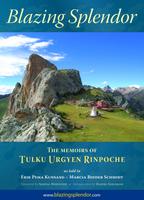 A lot of people have asked me to get a copy of the cover with the amazing photo of Fortress Peak, the hermitage of Samten Gyatso and Tulku Urgyen's former incarnation, and so, here it is.
A lot of people have asked me to get a copy of the cover with the amazing photo of Fortress Peak, the hermitage of Samten Gyatso and Tulku Urgyen's former incarnation, and so, here it is.You can download a large format of the color picture you see here. You might want it for your wall or bookstore. This is a test, and if it works out well, I have one twice the size. Remember, only click on the picture if you have a fast dial-up -- it was uploaded as 4.5 mb.
http://www.rangjung.com/blazingsplendor/poster-download.htm
I wrote a few word about the photo on http://blazing-splendor.blogspot.com/2005/08/fortress-peak-cover-picture.html
Wednesday, August 24, 2005
On the trail from Fortress Peak through Tsangsar County
 We are back on the trail between Fortress Peak and Dechen Ling (the Sanctuary of Great Bliss), splendid names, aren’t they? And the autumn weather was to die for. The photo I wanted to share with you here was taken under a juniper grove while our horses relaxed in the midday sun. On the map, the two retreat places may be near, but Tulku Urgyen Rinpoche’s father and guru lived two days apart by horse ride. And a most spectacular ride it is!
We are back on the trail between Fortress Peak and Dechen Ling (the Sanctuary of Great Bliss), splendid names, aren’t they? And the autumn weather was to die for. The photo I wanted to share with you here was taken under a juniper grove while our horses relaxed in the midday sun. On the map, the two retreat places may be near, but Tulku Urgyen Rinpoche’s father and guru lived two days apart by horse ride. And a most spectacular ride it is!Tulku Urgyen Rinpoche rode along these trails many times, from childhood until he left for Tibet, never to return to Nangchen again.
Tuesday, August 23, 2005
Was Tulku Urgyen Rinpoche the first lama in Malaysia and Singapore?
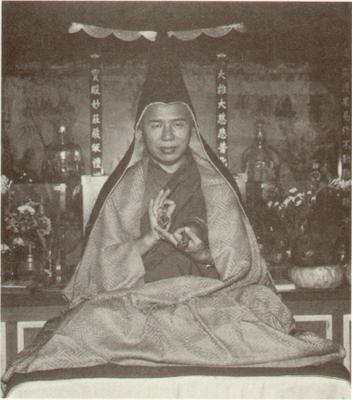 So far, the claim has been uncontested. In the early 1960’s, the Karmapa sent Tulku Urgyen Rinpoche to Ipoh as his personal representative. The photo here, I believe, is from that first visit. If some some of you know the story behind it or have other pictures from Rinpoche’s long stay at the Ipoh Cave, please post them here or send them to rangjung@gmail.com.
So far, the claim has been uncontested. In the early 1960’s, the Karmapa sent Tulku Urgyen Rinpoche to Ipoh as his personal representative. The photo here, I believe, is from that first visit. If some some of you know the story behind it or have other pictures from Rinpoche’s long stay at the Ipoh Cave, please post them here or send them to rangjung@gmail.com. The visit to Malaysia happened like this, in Tulku Urgyen’s own words:
Now I will tell you about my first trip to Malaysia. The English monk Lodrö Thaye had been to Malaysia and while in Ipoh three Chinese fellows – the monk Reverend Tong, Wahai and Asan – discussed with Lodrö Thaye, “We have heard about these Tibetan lamas and we would like to get an important one to come here to Ipoh. Who would be best?”
Lodrö Thaye replied, “The biggest is the Dalai Lama, below him they say it is the Karmapa.”
They then agreed that Lodrö Thaye should ask the Karmapa to send a lama to Ipoh.
In those days, Lodrö Thaye was friends with a lama at Tengpoche and asked him to go visit Malaysia. Being a Nepalese citizen, travel documents were no problem. It was all settled, they both agreed, the passport was ready but then Lodrö Thaye thought, “I was actually supposed to ask the Karmapa to send someone, so I better ask him.” I didn’t have much contact with Lodrö Thaye at this time, but before he went to see the Karmapa he come up to Nagi Gompa, to ask my advice.
First Lodrö Thaye told me, “I have three suggestions to put for to His Holiness: Sabchu Rinpoche from Swayambhu, Tengpoche Tulku and you. Would you be willing to go?”
“If the Karmapa says I have to go then I will. I’m not going to go against his word,” I said. “Otherwise, I have never been abroad and have no particular desire to do so.”
“Well then, I’ll relate that to the Karmapa,” said Lodrö Thaye.
He left for Rumtek, where he had lived before. But being talkative and moving around too much the local authorities began to suspect that he was a British spy and would not let him back in to Sikkim. In his place, George MacDonald, whom we simply called Sahib, went on ahead to ask which of the three lamas the Karmapa would recommend sending to Malaysia.
Karmapa said, “Sabchu is too old, he won’t work out. Tengpoche Tulku I don’t know personally, but I do know Tulku Urgyen – he should go.” That’s what Sahib and Lodrö Thaye came back and told me.
Sahib said, “Will you do it or not?”
“I am not going against the Karmapa’s word, so I’ll go,” I replied.
Our little gang of four robed people, were the first of our type to visit Malaysia. We got donations from the faithful Chinese Buddhists. They would hand over one envelope to the four of us to share among ourselves, except when I gave an empowerment and the donation would belong to me. The trip lasted three months and I was able to accumulate a decent amount of funds to bring back with me.
During the trip Lodrö Thaye asked, “How big of a monastery are you going to build?”
“Let’s wait and see,” I said, “I’ll build in accordance with whatever I get.”
At that time we didn’t have any plan to build Ka-Nying Shedrub Ling Monastery, I was only intending to improve Nagi Gompa. Things were going well until after two and a half months, Lodrö Thaye had a plan, he had obviously carved in stone, of going to England and he insisted on seeing me on a plane back to Nepal before he would leave. In short, he cut my trip to Malaysia short. The Malaysians wanted me to stay, but to no avail. Lodrö Thaye is a willful gentleman and he got his way.
Back in Nepal, while I was conferring with Ram Lal about what to do with the funds, a letter arrived from my two sons, Chokyi Nyima and Chokling, that the 16th Karmapa had commanded them that we build a large monastery in Boudha.
-- Tulku Urgyen Rinpoche, (not included in Blazing Splendor)
Swayambhu from the air
 Swayambhu is, besides the Great Stupa of Boudha, one of the most spectacular monuments in the Kathmandu Valley, wrought with anscient history and legend. Also here one of the lamas from Nangchen settled down, this time Sabchu Rinpoche (number 2 from left in http://blazing-splendor.blogspot.com/2005/08/four-nangchen-lamas-have-landed-in.html).The Kagyu temple in front of the stupa had been in the care of a Nepali lama who then ventured to Tsurphu in the 1950s and signed it over to the 16th Karmapa. The picture you see here was taken in 1965 by Ganesh Man Chitrakar, whom I never got a chance to ask. So, Ganesh Man Chitrakar, thanks to you for that great picture! (Click on the picture to see it at 153kb)
Swayambhu is, besides the Great Stupa of Boudha, one of the most spectacular monuments in the Kathmandu Valley, wrought with anscient history and legend. Also here one of the lamas from Nangchen settled down, this time Sabchu Rinpoche (number 2 from left in http://blazing-splendor.blogspot.com/2005/08/four-nangchen-lamas-have-landed-in.html).The Kagyu temple in front of the stupa had been in the care of a Nepali lama who then ventured to Tsurphu in the 1950s and signed it over to the 16th Karmapa. The picture you see here was taken in 1965 by Ganesh Man Chitrakar, whom I never got a chance to ask. So, Ganesh Man Chitrakar, thanks to you for that great picture! (Click on the picture to see it at 153kb)
Sunday, August 21, 2005
Four Nangchen lamas have landed in Boudha
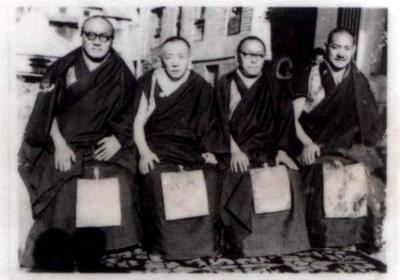 This blog serves as well as a conduit for sharing some of the old photos that didn’t make it through the final selection. And the ones we find later. Today I found this old picture of four Nangchen lamas who Tulku Urgyen Rinpoche counted among his close friends (from the left): Dabzang, Sabchu, Trarig and Andzin, Rinpoches. Dabzang Rinpoche resided at Dilyak monastery where Tulku Urgyen’s father visited on occasion. The three other lamas were brothers. They were among the first to build monasteries in the Kathmandu valley, at the two main stupas.
This blog serves as well as a conduit for sharing some of the old photos that didn’t make it through the final selection. And the ones we find later. Today I found this old picture of four Nangchen lamas who Tulku Urgyen Rinpoche counted among his close friends (from the left): Dabzang, Sabchu, Trarig and Andzin, Rinpoches. Dabzang Rinpoche resided at Dilyak monastery where Tulku Urgyen’s father visited on occasion. The three other lamas were brothers. They were among the first to build monasteries in the Kathmandu valley, at the two main stupas.
The nun with shining diamonds for eyes
 She was one tough little lady, that’s for sure. As a little girl she knew Chimey Dorje, Tulku Urgyen Rinpoche’s father who lived the Sanctuary of Great Bliss (Dechen Ling). And of course she knew Chimey Dorje’s family, including Tulku Urgyen whom she served during his stays at the hermitage. After the “Cultural” revolution put an end to spiritual practice in Tibet and Kham, Ani Jangchub remained behind, hiding in the caves and continuing her practice. The couple of days Marcia and I spent there, a special experience was to see the inner beauty that shone through her face as she daily would come and just hang out in our room, ask a few questions, give a few answers herself, but most sit still as a little sweet bird. There was a look and a brightness in her eyes that repeated caught me by surprise, at once sorrowful and detached, at peace in her grimy outfit. Propably the poorest and rishest person alive. She was happy to see us while she didn't know us at all. The tears in her eyes at times must have been from fond memories. Her last words: “Tell Chokyi Nyima Rinpoche that I was just left behind here and will never see him again in this life.”
She was one tough little lady, that’s for sure. As a little girl she knew Chimey Dorje, Tulku Urgyen Rinpoche’s father who lived the Sanctuary of Great Bliss (Dechen Ling). And of course she knew Chimey Dorje’s family, including Tulku Urgyen whom she served during his stays at the hermitage. After the “Cultural” revolution put an end to spiritual practice in Tibet and Kham, Ani Jangchub remained behind, hiding in the caves and continuing her practice. The couple of days Marcia and I spent there, a special experience was to see the inner beauty that shone through her face as she daily would come and just hang out in our room, ask a few questions, give a few answers herself, but most sit still as a little sweet bird. There was a look and a brightness in her eyes that repeated caught me by surprise, at once sorrowful and detached, at peace in her grimy outfit. Propably the poorest and rishest person alive. She was happy to see us while she didn't know us at all. The tears in her eyes at times must have been from fond memories. Her last words: “Tell Chokyi Nyima Rinpoche that I was just left behind here and will never see him again in this life.”
Subscribe to:
Posts (Atom)



